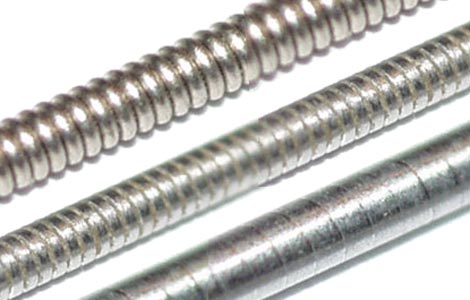A new set of strings can do wonders for a bass. If the old set have been on for a while, the sound they produce will be dull and lifeless. Old strings can be the cause of fret buzz and intonation problems, and in a worse-case scenario could snap during performance. Bass guitar strings last longer than guitar strings, but a new set can really invigorate your bass
How long a string takes to become ‘old’ depends on several factors: how much it is played, whether it is wiped down after use, and even how corrosive the perspiration of the player. Top players may change their strings nightly; only fresh strings give them the sound they want, whilst a bass that spends very little time in use – perhaps avoiding gig situations – will be fine for months or years.
So, now you’ve decided to treat your beloved bass to a new set, how do you decide what to buy? There are a lot of choices, but which ones are right for you? Long scale? shortscale? roundwound? flats?
This article describes some of the main types, to help the reader identify the best bass strings for them…
Bass guitar strings: scale
The scale of an instrument is effectively the length between nut and bridge saddles; the length that vibrates when you pluck an open string. Of course intonation adjustments at the bridge will vary this value slightly, so more often the scale is measured as twice the length between nut and twelfth fret.
The vast majority of basses will be short (30 1/2″) scale, or long (34 1/2″) scale; this can be measured with a tape measure in seconds. There are also other scales; medium (32″) and extra long (36″) but these are the exception.

In some instances, longer scale strings may be required. Basses with string through bodies (above), or very long headstocks may need longer strings than the actual scale of the bass suggests.
Bass guitar strings: tension
Tension can also be described as how taut the string is. There are a number of factors that affect tension – but when choosing a set of strings, only the gauge, material, and type of string are important. Too low tension will result in loss of volume, inferior tone and flappy, difficult to control strings. Too high tension may make the bass uncomfortable to play.
Typical gauges are 0.095″, 0.100″ and 0.105″; light, medium and heavy, or lower, medium and higher tension.
There are even lighter and heavier strings too. If you play fingerstyle, a lighter gauge will be more appropriate than if you prefer a pick.
The type of string is also relevant to tension – flatwounds have the highest tension – then halfrounds, with roundwounds having the lowest.
Round, Flat or Halfs?
Bass guitar strings: round, flat or halfs?
So what are the different string types?
 Roundwound
Roundwound
As can be seen, this string is made by winding a round cross-sectioned wire around a central core. It gives a brighter sound than flats (particularly steel roundwounds), but can be prone to finger squeaking when played. Roundwound strings are probably the most often used strings, but can cause significantly more fretwear than flatwounds. most popular roundwound strings
 Flatwound
Flatwound
Flatwound strings, as the name implies, are wound with a flat tape, and polished smooth. They are much mellower sounding than roundwounds, and are great for Jazz, RnB, and classic rock (they were all you could buy back in the day). No finger squeaking, and very little fret wear. most popular flatwound strings
 Half Round
Half Round
These strings combine elements of both roundwound and flatwound strings. They are somewhere in between with regard sound, and many players find halfs to be exactly the right balance. most popular halfround strings
So how do you know what to buy? Well what do you play?
If it’s punky slung-low rock, played with a plectrum you could go for some heavy gauge roundwounds. You’ll get a powerful punchy sound that can compete with overdriven guitars. Works well for slapping too.
If its mellow jazz played fingerstyle, try some light-medium gauge flats. Or some heavier ones if you use a pick. Flats sound great for classic rock – giving an authentic boom and rumble that was the signature sound of the 50s, 60s, and 70s.
But playing style isn’t the only thing to consider. Some older guitars are tricky to set up, perhaps a slight neck bow is preventing a low action. A change in neck tension can be used to your advantage. For example a slight upbow, can be reduced with lighter gauge roundwound strings, (or exaggerated with heavier flatwound strings)
Bass string brands
Manufacturers to look out for include La Bella, D’addario, GHS, Rotosound, Elixir, Ernie Ball, Thomastik and Warwick


Great article!
Thanks
Very interesting. I agree. I had my strings on for a long time and put on some new one and crikey, what a difference. Over time the sound really goes off although it isn’t noticeable over day by day.
With all these terribly sloppy e-how articles out there, it’s nice to see a well thought out, structured and informative article. Nice work!
aahhh – I always thought it was half-wound, not half-round. Makes more sense now. Great post.
Does choosing the right string have to do with the action setup on the bass?
If the action is high, perhaps a heavy gauge roundwound would be best right?
I guess jazz players go for low action and light flatwound then …
Great information on the bass keep up the good work – Jason